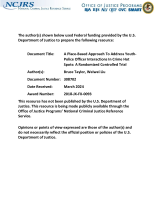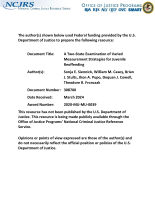Juvenile (under 18)
Disrupting the Pathways to Gang Violence for Youth of Color
A State-wide Analysis of Characteristics and Predictors of Dual System Involvement Among Child Victims of Human Trafficking
Adolescent Contact, Lasting Impact? Lessons Learned From Two Longitudinal Studies Spanning 20 Years of Developmental Science Research With Justice-System-Involved Youths
Urban Adolescents' Exposure to Violence and Racial Discrimination: Gender Differences in Coping and Mental Health
Building "A Beautiful Safe Place for Youth" Through Problem-oriented Community Organizing: A Quasi-experimental Evaluation
The Long-term Collateral Consequences of Juvenile Justice Involvement for Females
Characteristics and Dynamics of Cyberstalking Victimization Among Juveniles and Young Adults
Participatory Mapping of Holistic Youth Well-Being: A Mixed Methods Study
How Risky is Online Sexting by Minors?
Beyond Monolithic Threat: Understanding Risk Typology in Court-involved Black Male Youth
Webinar Transcript: NIJ FY 2024 Research and Evaluation on Youth Justice Topics
This webinar will provide an overview of the NIJ FY 2024 Research and Evaluation on Youth Justice Topics solicitation. In collaboration with the Office of Juvenile Justice and Delinquency Prevention, NIJ seeks applications for research and evaluation projects that inform policy and practice in the field of...
Adolescent Child Custody Loss and Substance Use Treatment as Predictors of Young Adult Substance use Trajectories Among Females with Foster Care and Juvenile Justice Involvement
Nashville Longitudinal Study of Youth Safety and Wellbeing
A Place-Based Approach To Address Youth-Police Officer Interactions In Crime Hot Spots: A Randomized Controlled Trial
A Two-State Examination of Varied Measurement Strategies for Juvenile Reoffending
Webinar Transcript: NIJ FY 24 Evaluation on Desistance
NIJ hosted a webinar providing an overview of the NIJ FY 24 Evaluation on Desistance Solicitation, in which NIJ seeks proposals for rigorous evaluations of desistance-focused interventions to advance understanding of strategies that might aid in the desistance process and identify innovative approaches to measure the desistance process.
Transcript...
NIJ FY24 Research on Multidisciplinary Teams
Webinar Transcript: FY 2024 NIJ Graduate Research Fellowship Program
Deadline notice
The deadline to submit an application under the solicitation discussed below has passed.
NIJ held a webinar on February 14, 2024, gave an overview of NIJ’s Graduate Research Fellowship opportunity, which invites applications for doctoral dissertation research that is relevant to preventing and controlling crime, advancing knowledge of victimization and effective victim services, or ensuring the fair and impartial administration...




